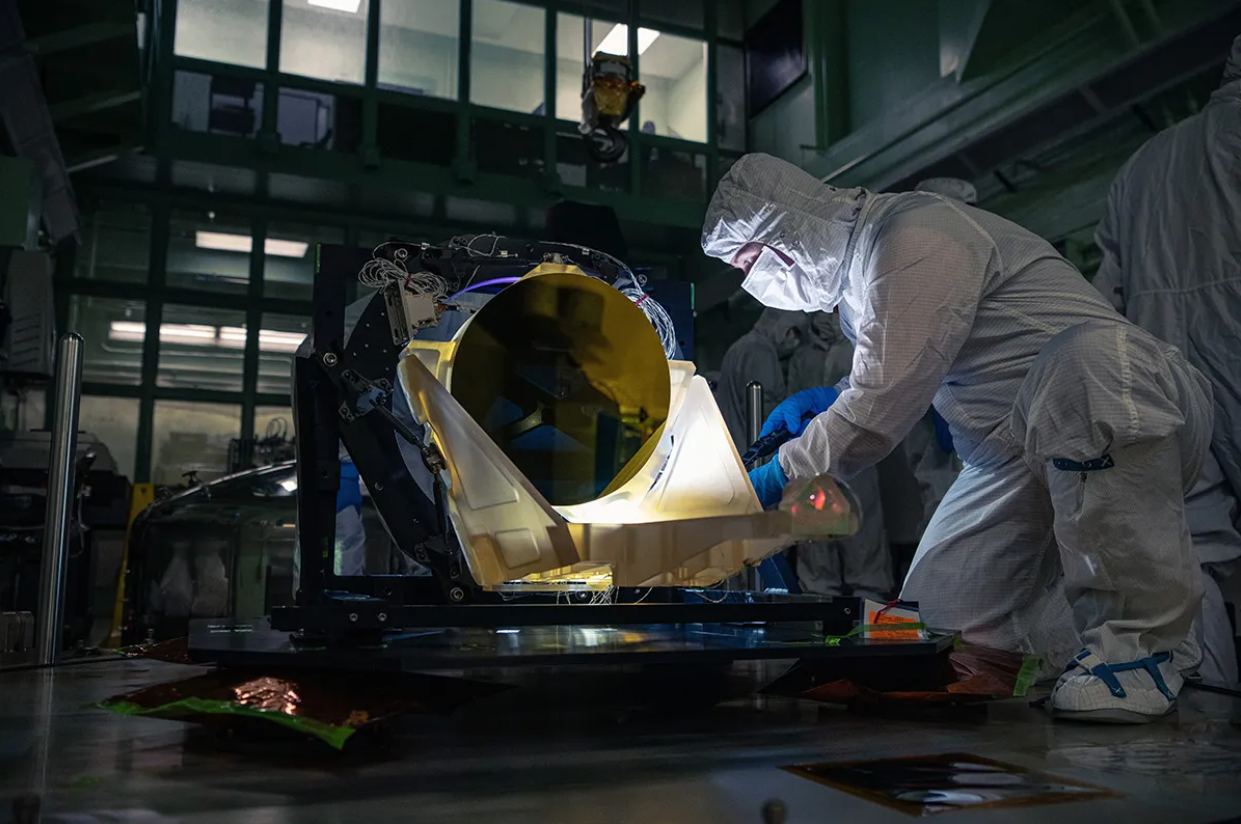
October 23, 2024 by Evan Gough
Collected at: https://www.universetoday.com/168976/nasa-is-building-telescopes-for-the-lisa-mission/
Some of the most cataclysmic and mysterious events in the cosmos only reveal themselves by their gravitational waves. We’ve detected some of them with our ground-based detectors, but the size of these detectors is limited. The next step forward in gravitational wave (GW) astronomy is a space-based detector: LISA, the Laser Interferometer Space Antenna.
When dense objects like black holes and neutron stars orbit each other and merge, they create gravitational waves. These ripples in space-time, which Einstein predicted in 1915, were observed for the first time in 2015 by LIGO (Laser Interferometer Gravitational-Wave Observatory). Now, we’ve observed dozens of them.
Ground-based detectors like LIGO have two long “arms” at right angles to each other. A powerful laser beam is split into two identical beams that travel down each arm, or tunnel, that are several kilometres apart. The beams are reflected back and forth by mirrors at the ends of the arms, and when they combine, they interfere with each other. Whenever a GW passes through Earth, it warps spacetime. That makes one arm longer than the other, which changes the interference pattern in the beams.

The length of the arms limits the sizes of the GWs LIGO can detect and also limits the type of mergers it can detect. It can only detect higher-frequency GWs from 10 to 1,000 Hertz, which come from merging pairs of black holes (BH), merging pairs of neutron stars (NS) and merging mixed pairs of BHs and NSs.
LISA will be much different. It doesn’t have the same arm-length limitation. LISA will be the first dedicated space GW observatory, and it will consist of three separate spacecraft arranged in an equilateral triangle. Each spacecraft will be 2.5 million km apart, meaning LISA’s arms will be 2.5 million km long.

The ESA/NASA LISA mission is the next step in gravitational wave (GW) astronomy. With its much longer arms, LISA will detect low-frequency waves from 0.1 mHz to 1 Hz and expand our search for GWs and the events that create them. It’ll detect GWs from other sources, like supermassive black hole (SMBH) mergers, binary white dwarf systems, and Extreme Mass Ratio Inspirals (EMRIs). (EMRIs are systems where objects like a stellar-mass black hole or a white dwarf spiral into an SMBH.)
Like LIGO, LISA will also be a laser interferometer. Any change in its laser interference pattern can be attributed to a GW. However, LISA will do more than just detect GWs. It can determine other characteristics in the complex GW waveforms, like black hole spin.
NASA is busy working on the mission, which isn’t scheduled to launch until 2035. They’ve given us our first look at a full-scale prototype of the six cameras LISA will rely on.
“Twin telescopes aboard each spacecraft will both transmit and receive infrared laser beams to track their companions, and NASA is supplying all six of them to the LISA mission,” said Ryan DeRosa, a researcher at NASA’s Goddard Space Flight Center in Greenbelt, Maryland. “The prototype, called the Engineering Development Unit Telescope, will guide us as we work toward building the flight hardware.”

The telescopes are made to be stable over a wide temperature range since precision is key to success. They need to detect changes as small as picometers, or trillionths of a meter, between each spacecraft. Unlike LIGO, the three spacecraft that make up the system cannot be kept at precise distances from one another. Over each year’s orbit, the distance between them changes significantly, and the system has to track the changes to guarantee precision.
The thin layer of gold is highly reflective in the infrared range that LISA’s lasers will use. It also minimizes thermal absorption and provides consistent reflectivity over long periods of time. Gold also resists corrosion, protects the underlying layer from degradation, and is thermally stable.
LISA has another trick up its sleeve: free-floating cubes or test masses. They reflect the lasers back and forth between the spacecraft and are a critical part of its detection system. They’re 46mm solid cubes made of gold-platinum alloy that weigh approximately 2 kg each. The cubes are extremely pure and will have a homogeneous material composition. They’ll float freely inside electrode housings within each spacecraft. The cubes serve as reference points for GW measurement.
The ESA and NASA have already tested some of LISA’s components in space. In 2015, the ESA launched the LISA Pathfinder mission. It tested a much smaller version of one of LISA’s arms and also tested the cubes. It placed two test masses in a near-perfect gravitational free-fall and controlled and measured their motion with unprecedented accuracy.

We’ve come a long way since Einstein predicted gravitational waves. When the first one was detected in 2015, it opened a new window into the cosmos.
LISA will throw that window wide open and reveal galaxy-defining events like supermassive black hole mergers.

Leave a Reply